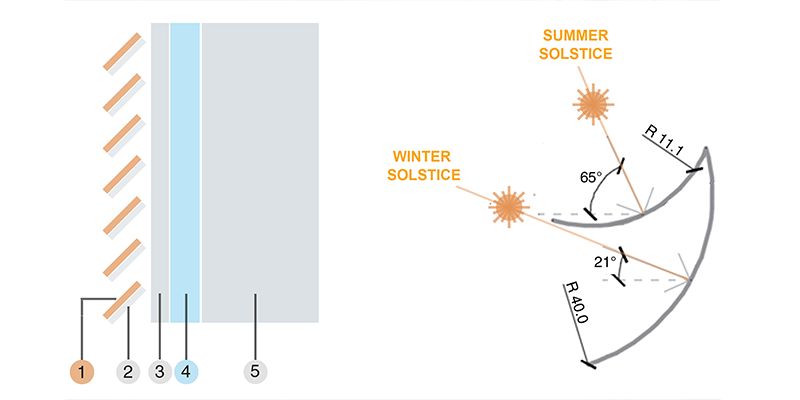Combining Timber and Photovoltaic Technologies
Downloads
DOI:
https://doi.org/10.7480/jfde.2018.3.2602Keywords:
adaptive façades, adaptive component, hygromorpic materials, BIPV technology, wood, timberAbstract
The paper presents the first results of research that was partly conducted within the framework of European COST Action TU1403 – Adaptive Façades Network, on the development of an adaptive BIPV (Building Integrated Photovoltaic) solution able to change its curvature in relation to the external environmental conditions, orientating itself in order to optimise the energy production without the aid of any mechanical and electrical systems. After analysing the characteristics of the main adaptive materials that are currently used for such applications, the contribution outlines the main features of the proposed system, which consists of thin film solar cells coupled with a thin layer of hygromorphic material, manufactured from two wooden slats joined together and produced from different types of wood and trunk cuts. The hygromorphic layer thus obtained can change its shape as a function of temperature and relative humidity of outdoor conditions, thanks to the different expansion coefficients of the two wooden slats. To evaluate the performance of the component, three shape configurations for the adaptive strips have been assumed. For each hypothesis, the lamellae have been modelled using the Rhinoceros 5 Software, according to the curvatures taken during the different months of the year. The Rhino models have been imported into Autodesk Ecotect Analysis to calculate the incident solar radiation and to study the self-shadowing effect in the various configurations (in relation to the climatic conditions of the city of Milan). The paper outlines the system and PV energy production optimisation process, as well as possible applications in the field of façade design.
How to Cite
Published
Issue
Section
License
Copyright (c) 2018 Enrico Sergio Mazzucchelli, Mark Alston, Marcin Brzezicki, Luisa Doniacovo

This work is licensed under a Creative Commons Attribution 4.0 International License.
Authors or their institutions retain copyright to their publications without restrictions.
References
Andresen, I., Kleiven, T., Knudstrup, M., & Heiselberg, P. (2008). Methods and Tools for Designing Integrated Building Concepts. State-of-the-art Review. Vol. 2B. DCE Technical Report No. 049. International Energy Agency. Aalborg: Aalborg University.
Doniacovo, L. (2016). Studio, progettazione e modellazione di un sistema fotovoltaico innovativo integrato nell’involucro edilizio [Study, design and modelling of an innovative photovoltaic system integrated into the building envelope]. (Master’s Thesis). Politecnico di Milano.
European Commission (2013). Energy-efficient buildings - Multi-annual roadmap for the contractual PPP under Horizon 2020. Luxembourg: Publications Office of the European Union. doi:10.2777/29993
International Energy Agency (2013). Technology Roadmap - Energy efficient building envelopes. Paris: IEA Publications.
Holstov, A., Bridgens, B.N., & Farmer G. (2015). Hygromorphic materials for sustainable responsive architecture. Construction and Building Materials, 98, pp.570-582.
Jermer, J. (Ed.). (2012). WoodExeter - Service life and performance of exterior wood above ground - Final report. Borås: SP Sveriges Tekniska Forskningsinstitut.
Loonen, R.C.G.M., Rico-Martinez, J.M., Favoino, F., Brzezicki, M., Menezo, C., La Ferla, G., & Aelenei, L. (2015). Design for façade adaptability – Towards a unified and systematic characterization. Proceedings of the Advanced Building Skins 2015, 3-4 November 2015, Bern, Switzerland.
Loonen, R.C.G.M., Trčka, M., Cóstola, D., & Hensen, J.L.M. (2013). Climate adaptive building shells: State-of-the-art and future challenges. Renewable and Sustainable Energy Reviews . 25, pp.483–493.
Luthander, R., Widén, J., Nilsson, D., & Palm, J. (2015). Photovoltaic self-consumption in buildings: A review. Applied Energy, 142, pp.80–94.
Mazzucchelli, E.S. (2013). Edifici ad energia quasi zero – Materiali, tecnologie e strategie progettuali per involucri e impianti innovativi ad alte prestazioni. [Nearly Zero Energy Buildings - Materials, technologies and design strategies for innovative high performance envelopes and building services]. Maggioli Editore.
Mazzucchelli, E.S., & Doniacovo, L. (2017). The integration of BIPV Adaptive Flakes in the building envelope. Proceedings of the 12th Conference on Advanced Building Skins, 2-3 October 2017, Bern, Switzerland.
Schumacher, M., Schaeffer, O., & Vogt, M. (2010). Move: Architecture in Motion - Dynamic Components and Elements. Basel: Birkhäuser
Tress, W. (2014). Organic solar cells - Theory, Experiment and Device Simulation. Springer Series in Material Science, vol.208.
Wigginton, M., & Harris, J. (2002). Intelligent Skins. Oxford: Butterworth-Heinemann.
